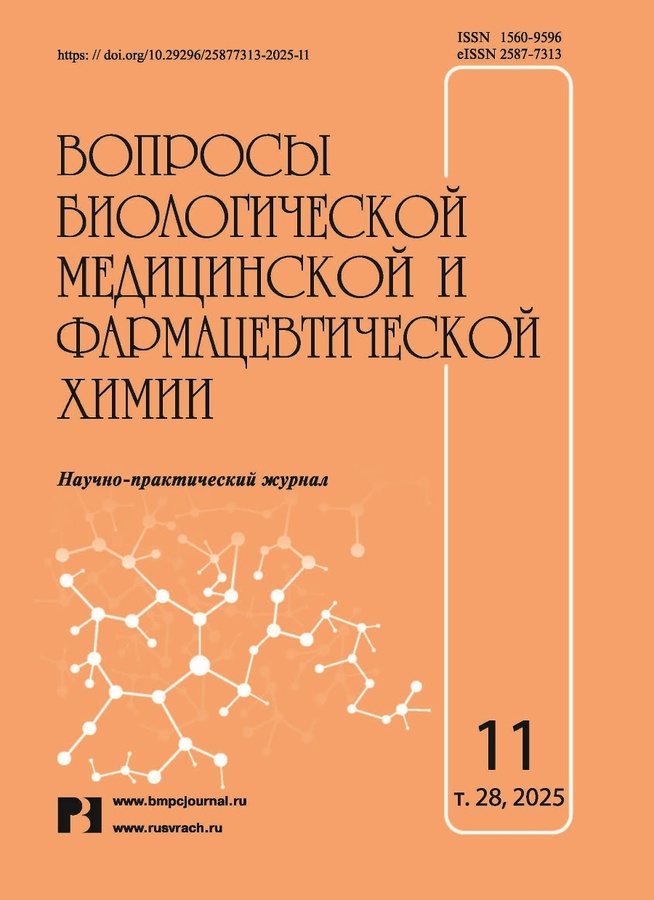The study of the polysaccharide complex of the grass of the Agrimonia eupatoria L.
- 作者: Iuldasheva A.A.1, Pupykina K.A.1, Dargaeva T.D.2, Ferubko E.V.2
-
隶属关系:
- Bashkir State Medical University Ministry of Health of the Russian Federation
- All-Russian Scientific Research Institute of Medicinal and Aromatic Plants
- 期: 卷 28, 编号 11 (2025)
- 页面: 31-36
- 栏目: Pharmaceutical chemistry
- URL: https://journals.eco-vector.com/1560-9596/article/view/696144
- DOI: https://doi.org/10.29296/25877313-2025-11-04
- ID: 696144
如何引用文章
详细
Introduction. Currently, medicinal plants that are widely used in folk medicine are promising objects for study. This is due to the fact that their poorly studied chemical composition, biological activity, and lack of regulatory documentation limit the possibility of their introduction into scientific medicine in order to expand the range of herbal medicines. In this regard, plants of the genus Agrimonia L. are interesting objects of study. The grass of the Agrimonia eupatoria L. is used as an antibacterial, anti-inflammatory, astringent, choleretic, hepatoprotective, tonic, hemostatic agent. To substantiate the relationship between pharmacological activity and chemical composition, it is relevant to study the polysaccharide complex of the Agrimonia eupatoria L., which is poorly understood, however, it can have a positive effect on various processes occurring in the human body.
The aim of the work – to study the composition of the polysaccharide complex of the Agrimonia eupatoria L.
Material and methods. The object of the study was the air-dry crushed grass of the Agrimonia eupatoria L., harvested in 2023-2025 in the Republic of Bashkortostan during the mass flowering period. Conventional qualitative reactions were performed to detect polysaccharides in medicinal plant raw materials. The polysaccharide complex from the grass of the Agrimonia eupatoria L. was obtained by fractional separation into water-soluble polysaccharides, pectin substances, hemicellulose A and hemicellulose B according to the method of Kochetkov. The monosaccharide composition of polysaccharide complexes was studied after acid hydrolysis and subsequent chromatography on paper in various systems by descending and ascending chromatography in comparison with standard samples of monosaccharides, aniline phthalate was used as a detector.
Results. The studies of the polysaccharide complex of the grass of the Agrimonia eupatoria L. made it possible to isolate and fractionalize polysaccharides into water-soluble polysaccharides (VPS), pectin substances (PV) and hemicelluloses A and B (HC A and HCB). Their content has been quantified using the gravimetric method. It was found that fractions of water-soluble polysaccharides (10.27±0.41%) and hemicellulose A (19.26±0.84%) predominate in the plant, with a lower content of pectin substances – 8.95±0.37% and hemicellulose B – 6.58±0.31%. An assessment of the external features and physico-chemical characteristics of the isolated complexes was carried out. Chromatographic analysis was used to study the composition of the products of acid hydrolysis of polysaccharides of the Agrimonia eupatoria L. and found that 6 sugars were found in the composition of the VPS, which, in comparison with standard samples, were identified as glucose, fructose, galactose, arabinose, rhamnose, xylose. The hydrolysate of the pectin complex contains 5 monosaccharides, which are identified with known samples as glucose, galactose, arabinose, xylose, rhamnose and galacturonic acid. Galactose, arabinose, glucose, xylose, and rhamnose were found in hemicelluloses A and B.
Conclusions. The conducted studies made it possible to isolate and fractionalize the polysaccharides of the Agrimonia eupatoria L. into VPS, PV, HC A and HCB. The monosaccharide composition of polysaccharide complexes has been established, which is represented by neutral sugars – glucose, fructose, galactose, arabinose, rhamnose, xylose and acidic – galacturonic acid. The high content of polysaccharides in the grass of the Agrimonia eupatoria L. indicates the prospects for their further use.
全文:
作者简介
A. Iuldasheva
Bashkir State Medical University Ministry of Health of the Russian Federation
编辑信件的主要联系方式.
Email: aisulu99.ru@mail.ru
ORCID iD: 0009-0001-3225-8482
Assistant of the Department of Pharmacology
俄罗斯联邦, 3 Lenina str., Ufa, Republic of Bashkortostan, 450008K. Pupykina
Bashkir State Medical University Ministry of Health of the Russian Federation
Email: pupykinaka@gmail.com
ORCID iD: 0000-0001-8817-7289
SPIN 代码: 8148-8493
Dr.Sc. (Pharm.), Professor of the Department of Pharmacognosy and Botany
俄罗斯联邦, 3 Lenina str., Ufa, Republic of Bashkortostan, 450008T. Dargaeva
All-Russian Scientific Research Institute of Medicinal and Aromatic Plants
Email: eferubko@yandex.ru
ORCID iD: 0000-0002-0722-9479
SPIN 代码: 1621-1902
Dr.Sc. (Pharm.), Chief Researcher at the Center for Chemistry and Pharmaceutical Technology
俄罗斯联邦, 7 Grina str., Moscow, 117216E. Ferubko
All-Russian Scientific Research Institute of Medicinal and Aromatic Plants
Email: eferubko@yandex.ru
ORCID iD: 0000-0003-1949-2597
SPIN 代码: 3419-3927
Dr.Sc. (Med.), Head of the Department of Experimental Pharmacology
俄罗斯联邦, 7 Grina str., Moscow, 117216参考
- Naumova L.G., Mirkin B.M., Muldashev A.A. i dr. Flora i rastitel'nost' Bashkortostana: Uchebnoe posobie. Ufa. Izd-vo BGPU. 2011. 174 s. (In Russ.).
- Zhigunova S.N. Analiz lekarstvennoj flory Respubliki Bashkortostan. Samarskaja Luka: problemy regional'noj i global'noj jekologii. 2018; 27(4(1)): 109–117. doi: 10.24411/2073-1035-2018-10098. (In Russ.).
- Paluch Z., Biriczová L., Pallag G. et al. The therapeutic effects of Agrimonia eupatoria L. Physiol Res. 2020 Dec 31; 69(Suppl 4): S555–S571. doi: 10.33549/physiolres.934641.
- Golovkin B.N., Rudenskaya R.N., Trofimova I.A. i dr. Biologicheski aktivny`e veshhestva rastitel`nogo proisxozhdeniya: v 3 t. M.: Nauka. 2001; 1: 350 s. (In Russ.).
- Gulyaev D.K., Belonogova V.D., Rudakova I.P. Sostav i biologicheskaya aktivnost` polisaxaridov pobegov i list`ev maliny` oby`knovennoj (Rubus idaeus L.). Tradicionnaya medicina. 2017; 51(4): 39–42. (In Russ.).
- Malheiros J., Simões D.M., Figueirinha A. et al. Agrimonia eupatoria L.: An integrative perspective on ethnomedicinal use, phenolic composition and pharmacological activity. J Ethnopharmacol. 2022 Oct 5; 296: 115498. doi: 10.1016/j.jep.2022.115498.
- Kudashkina N.V., Xasanova S.R., Meshheryakova S.A. Fitoximicheskij analiz: ucheb. posobie po farmakognozii dlya studentov. Ufa.: Izd-vo GOU VPO BGMU ROSZDRAVa. 2007. 281 s. (In Russ.).
- Shamsutdinova S.R., Abdullina L.T., Pupykina K.A. Opredelenie soderzhaniya polisakharidov v kornyakh i trave bodyaka polevogo. Vestnik Bashkirskogo gosudarstvennogo meditsinskogo universiteta (setevoe izdanie). 2017; 2(prilozh.): 860–864 (In Russ.).
- Stepanenko Olennikov D.N., Tankhaeva L.M. Metodika kolichestvennogo opredeleniya gruppovogo sostava uglevodnogo kompleksa rastitelʹnykh obʺektov. Khimiya rastitelʹnogo syrʹya. 2006; 4: 29–33. (In Russ.).
补充文件





